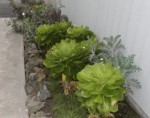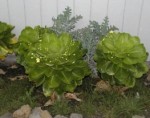Scientific Name: Brighamia insignis
Endemic; Endangered: Kaua’i Only
Description: The alula often referred to a ‘olulu is a magnificent, almost prehistoric looking plant. This plant has a fat, succulent stalk (single stalk, sometimes branched) that emerges up from the ground with a rosette of large,rounded light green leaves on top. It has yellow flowers that protrude up from the leaf axises on long stem like tubes. When in bloom the flowers can completely encircle the top of the plant almost resembling a crown. The flowers are gently fragrant and are about 2 inches in diameter. Because of its appearance, people commonly call this plant ‘Cabbage on a Baseball Bat’.
Distribution: This federally listed endangered plant is endemic to the islands of Kaua’i and Ni’ihau although it hasn’t been seen for some time on the latter island, some reports even state that now on Kaua’i there is only one plant left in the wild. In the past one source says that it has also been seen on the Wai’anae mountains on O’ahu. Naturally they are found high up on exposed sea cliffs such as those on the Na Pali coast on Kaua’i. There is also a similar species (B. rockii) that is found on the sea cliffs of Molokai that closely resembles this plat but has larger white flowers with smaller, rounder leaves.
Landscape Use and Care: This plant is excellent for those people interested in xeriscape gardens. It thrives in full sun but does O.K. in partial shade. The alula does not like to have continuously wet roots so you should let the soil dry out in between waterings. If the soil is always wet at your home, the alula does fine in a pot. Watch out for red and black flat mites on the underside of leaves they will cause the leaves to become spotty and ugly. Slugs can also do a number on the stem of this plant sometimes eating through it over night so watch out for those little buggahs too.
Additional Info: One of the reasons why this plant is endangered is because it is presumed that its natural, native pollinator has gone extinct so there is nothing out in the wild to help it reproduce. You may have seen an episode of National Geographic (or in the IMAX) that showed two men who risk their lives repelling down these enormous sea cliffs to hand pollinate the flowers of this beautiful plant slowing or perhaps even preventing its demise.
Olulu/Alula

